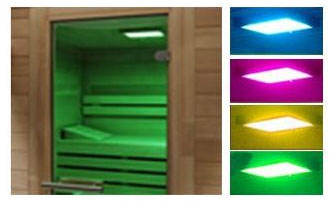Sauna with Color Therapy
The science of how colors affect us is at least 200 years old, maybe longer. It was in the early 19th century that writer and naturalist Johann Wolfgang von Goethe (1749-1832) published his groundbreaking works on color psychology.
Colors are all around us and without thinking about it, we shape our surroundings based on our preferences. We make color choices every time we decide what to wear, what to eat and how to decorate our homes. The colors we surround ourselves with during our daily lives affect us, our behavior and our emotions. By increasing our awareness of the power of colors, we can start using them to make positive changes in our lives. 
Different colors in a sauna
Many psychologists have studied colors and their meaning and have found that colors are perceived differently and create some kind of reaction in most people. However, it has been difficult to clarify exactly what colors make us feel because it also depends to some extent on culture, time and place. Although there is some disagreement about how colors affect us, there is a consensus that they are important, and that they often control us more than we think. Psychologists and scientists do not fully agree on what colors do to us, but they do agree that there is an impact on our emotions and behaviors.
Color as an influence
The method of using colors to affect people physically and psychologically is called chromotherapy. This knowledge has long been known in many ancient cultures in Egypt, Persia, Tibet, India and China. In the West, the use of colour for therapeutic purposes has not been as widespread. In the early 20th century, Rudolf Steiner, on the basis of Goethe's color theory, developed a special use of colors in art and therapy. Since then, further impulses have made color therapy more widespread. Today, light and color are also used in various ways in established health care in many countries.
Chromotherapy, sometimes called color therapy, colorology, color therapy or chromatherapy, is an alternative medicine method, which is considered a pseudoscience. In our range of saunas, you will find chromotherapy units in the ceiling of all models. Some models also have so-called professional color therapy which means a higher LUX / LED light that illuminates the area.
Yellow color
Stimulates the senses and clears the mind, relieves depression, facilitates digestion, increases the desire for knowledge, enhances memory and logical thinking and learning ability.
Blue color Has a calming effect on the body and mind. Suitable for creative thinking and meditation.
Green color
Refreshing and relaxing effect reduces anxiety. Relieves stress symptoms and headaches, promotes reconciliation and forgiveness.
Red color
Motivates, encourages and "speeds up" increased adrenaline. Promotes passion, vitality and a sense of well-being. Affects the bloodstream and lungs.
Orange color
Stands for strength, boldness is a color of activity.
Violet color
Brings calm and serenity.
Wine red color
Invites to well-being.
Brown color
Provides security and trust.
Turquoise color
Promotes the ability to make decisions.
Indigo color
Stands for intuition and spirituality.
